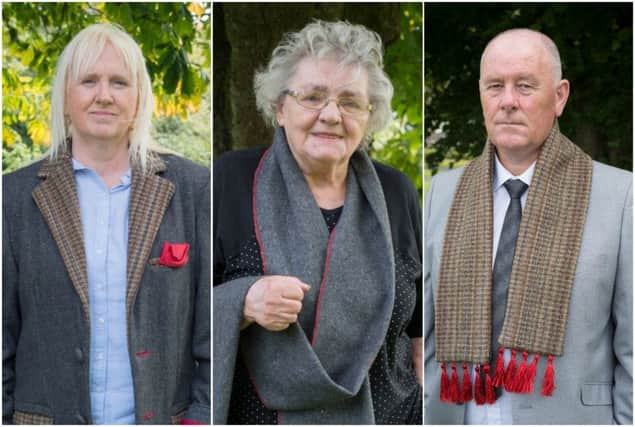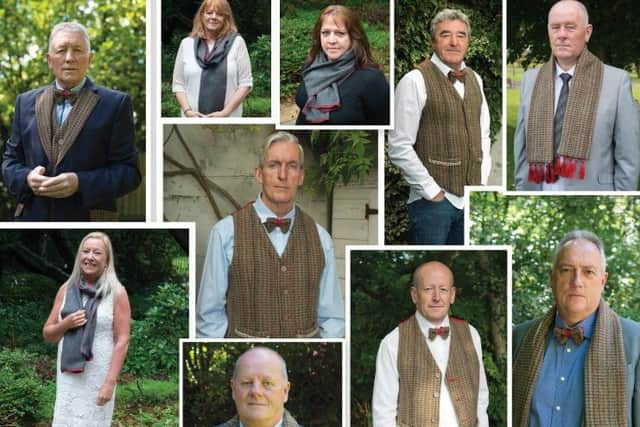Artist behind new '˜Blanket Protest' Calendar to hold signing in Derry


Laurence McKeown’s calendar features Derry man Pius McNaught, and local women Mary Nelis and Kathleen McCann and 16 others who were either on the Blanket Protest, which started in September 1976 and ended in October 1981 or wore it on the outside in solidarity with relatives in the jail.
An iconic photograph of Mary and Kathleen outside St Eugene’s Cathedral with the blanket and a sign saying ‘What About Our Sons and Husbands?’ became one of the most enduring images of the struggle. The Derry women had staged the protest during an event involving the Bishop ringing the bells for peace.
Advertisement
Hide AdAdvertisement
Hide AdThe protest was enacted as authorities tried to make political prisoners wear prison uniforms and ended, after the deaths of 10 Hunger Strikers, with the prisoners securing their demand to wear their own clothes.


An author, filmmaker, and playwright, Mr McKeown is a former republican prisoner who spent 16 years in the H-Blocks of Long Kesh. He was on the Blanket Protest for four and a half years, and on the 1981 hunger strike for 70 days.
The calendar signing will take place tomorrow (Saturday) at Checkpoint Charlie, Waterloo Street from 10.30am to 11.30am, where it is on sale.
The calendar forms part of Mr McKeown’s project, ‘We Wore The Blanket’, the output from which will be a multi-media exhibition.
Advertisement
Hide AdAdvertisement
Hide AdExplaining how the calendar project came about, Mr McKeown told the Journal: “Basically, I got an original blanket from the jail once it closed. I had it in the attic along with other memorabilia and because I work in the arts and last year was the 40th anniversary, I thought it would be timely to do something.”


Mr McKeown said the history of the Blanket Protest was already well documented and as he was working in the arts he decided to look at it from a fresh angle.
The wider project explores how a blanket, traditionally associated with newborns, being a thing of comfort, being taken in an ambulance, in the context on the Troubles here became a symbol of protest and resistance.
For the calendar, Mr McKeown took the original H-Block blanket and enlisted the help of a talented dressmaker from Newry to create a number of items of clothing from it. The blanket was then transformed into a bow tie, a tie, a waistcoat, a Crombie coat, and several scarves.
Advertisement
Hide AdAdvertisement
Hide Ad“I also requested she alter a dress jacket I had to include elements of the blanket. The idea was to subvert the usual image of the blanket protest – of beards, long hair, prison cells, street protests – by photographing a number of those involved in the blanket protest wearing these items of clothing. They would be elegant photos; photographs of people who were proud of the contribution they had made and who today ‘wear the blanket’ as a mark of honour,” Mr McKeown said.
“I wanted to show we were proud of it. It shaped our lives in many ways, in terms of the conflict and in general, and we remain a part of it. They were hard times but it was about showing that we came through them.”
The photos were also taken in the free and open natural locations “in stark contrast to the grey concrete and steel doors of a prison cell”.
Mr McKeown said that threads from the blankets were sometimes used as lines of communication and exchange items between cells, and he hoped to incorporate this aspect of life inside within an artistic exhibition.
Advertisement
Hide AdAdvertisement
Hide AdThe calendar is unique in that it starts in March 2018 and ends in September 2019 to reflect the timeline of the criminalisation policy of the British government, which sparked the Blanket Protest, the start of Bobby Sands’ Hunger Strike and the ‘Great Escape’ from the Maze of September 1983.
Many who had been on the blanket protest took an active part in the escape.
Photographic sessions were held in Belfast, Derry City, South Derry, and South Armagh. Due to restrictions on time and space, not all those photographed in the initial sessions could be photographed again for the calendar but they will all feature in any future exhibition.
“My warmest thanks to everyone who gave of their time so willingly,” Laurence said.
As well as Checkpoint Charlie, copies of the calendar can also be purchased directly by messaging Laurence on Facebook or email: [email protected].